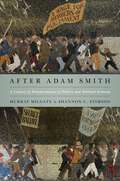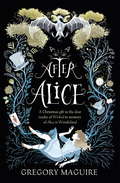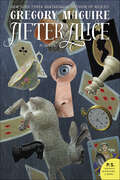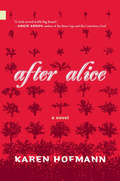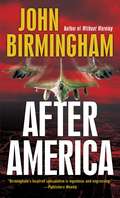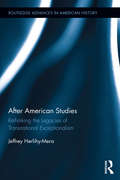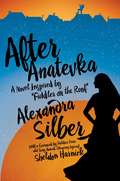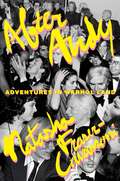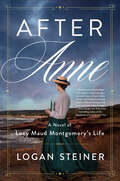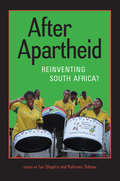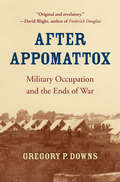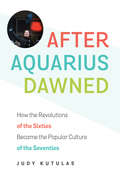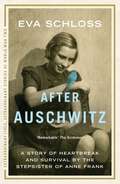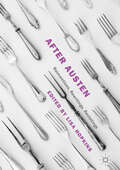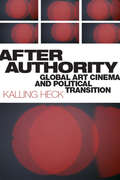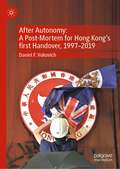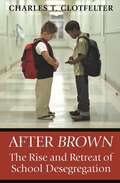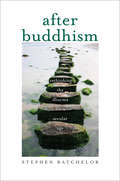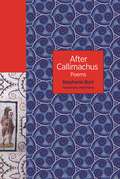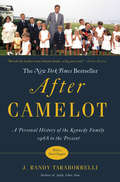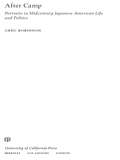- Table View
- List View
After Adam Smith: A Century of Transformation in Politics and Political Economy
by Shannon C. Stimson Murray MilgateHow writers after Adam Smith helped shape our thinking about economics and politicsFew issues are more central to our present predicaments than the relationship between economics and politics. In the century after Adam Smith's Wealth of Nations the British economy was transformed. After Adam Smith looks at how politics and political economy were articulated and altered. It considers how grand ideas about the connections between individual liberty, free markets, and social and economic justice sometimes attributed to Smith are as much the product of gradual modifications and changes wrought by later writers.Thomas Robert Malthus, David Ricardo, James Mill, John Stuart Mill, and other liberals, radicals, and reformers had a hand in conceptual transformations that culminated in the advent of neoclassical economics. The population problem, the declining importance of agriculture, the consequences of industrialization, the structural characteristics of civil society, the role of the state in economic affairs, and the possible limits to progress were questions that underwent significant readjustments as the thinkers who confronted them in different times and circumstances reworked the framework of ideas advanced by Smith—transforming the dialogue between politics and political economy. By the end of the nineteenth century an industrialized and globalized market economy had firmly established itself. By exploring how questions Smith had originally grappled with were recast as the economy and the principles of political economy altered during the nineteenth century, this book demonstrates that we are as much the heirs of later images of Smith as we are of Smith himself.Many writers helped shape different ways of thinking about economics and politics after Adam Smith. By ignoring their interventions we risk misreading our past—and also misusing it—when thinking about the choices at the interface of economics and politics that confront us today.
After Alice
by Gregory MaguireAfter Alice by Gregory Maguire, the bestselling author of WICKED, is a wonderful retelling of what happened next after Alice disappeared down the rabbit hole. An entertaining spin on Lewis Caroll's classic tale of Alice in Wonderland, this novel will delight fans of Angela Carter. When Alice fell down the rabbit-hole, she found Wonderland as rife with inconsistent rules and abrasive egos as the world she left behind. But how did Victorian Oxford react to Alice's disappearance?Gregory Maguire turns his imagination to the question of underworlds, undergrounds, underpinnings -and understandings old and new, offering an inventive spin on Carroll's enduring tale. Ada, a friend mentioned briefly in Alice's Adventures in Wonderland, sets out to visit Alice but, arriving a moment too late, tumbles down the rabbit-hole herself. Ada brings to Wonderland her own imperfect apprehension of cause and effect as she embarks on an odyssey to find Alice and bring her safely home from this surreal world below the world. The White Rabbit, the Cheshire Cat and the bloodthirsty Queen of Hearts interrupt their mad tea party to suggest a conundrum: if Eurydice can ever be returned to the arms of Orpheus, or if Lazarus can be raised from the tomb, perhaps Alice can be returned to life. Either way, everything that happens next is After Alice.
After Alice: A Novel
by Gregory MaguireFrom the multi-million-copy bestselling author of Wicked comes a magical new twist on Lewis Carroll’s beloved classic, Alice’s Adventures in Wonderland.When Alice toppled down the rabbit-hole 150 years ago, she found a Wonderland as rife with inconsistent rules and abrasive egos as the world she left behind. But what of that world? How did 1860s Oxford react to Alice’s disappearance?In After Alice, Gregory Maguire turns his dazzling imagination to the question of underworlds, undergrounds, underpinnings—and understandings old and new, offering an inventive spin on Carroll’s enduring tale. Ada, a friend of Alice’s mentioned briefly in Alice’s Adventures in Wonderland, is off to visit her friend, but arrives a moment too late—and tumbles down the rabbit-hole herself.Ada brings to Wonderland her own imperfect apprehension of cause and effect as she embarks on an odyssey to find Alice and see her safely home from this surreal world below the world. If Eurydice can ever be returned to the arms of Orpheus, or Lazarus can be raised from the tomb, perhaps Alice can be returned to life. Either way, everything that happens next is “After Alice.”
After Alice: A Novel (Nunatak First Fiction Series #37)
by Karen Hofmann"After retiring from the heady world of academia, Sidonie von Täler has returned to the small Okanagan Valley town she escaped in her youth for the lights of the big city. The family orchard has since gone to seed, and even decades later Sidonie still finds herself living in the shadow of her deceased older sister Alice. As she gets down to work sifting through the detritus of her family’s legacy, Sidonie is haunted by memories of trauma and triumph in equal measure, and must find a way to reconcile her past and present while reconnecting with the family members she has left. Karen Hofmann’s debut novel blends a poetic sensibility with issues of land stewardship, social stratification and colonialism, painting the geological and historical landscape of the Okanagan in vivid and varied colours."
After America (The Disappearance #2)
by John BirminghamMarch 14, 2003, was the day the world changed forever. A wave of energy slammed into North America and devastated the continent. The U. S. military, poised to invade Baghdad, was left without a commander in chief. Global order spiraled into chaos. Now, three years later, a skeleton U. S. government headquartered in Seattle directs the reconstruction of an entire nation-and the battle for New York City has begun. Pirates and foreign militias are swarming the East Coast, taking everything they can. The president comes to the Declared Security Zone of New York and barely survives the visit. The enemy-whoever they are-controls Manhattan’s concrete canyons and the abandoned flatlands of Long Island. The U. S. military, struggling with sketchy communications and a lack of supplies, is mired in a nightmare of urban combat. Caught up in the violence is a Polish-born sergeant who watches the carnage through the eyes of an intellectual and with the heart of a warrior. Two smugglers, the highborn Lady Julianne Balwyn and her brawny partner Rhino, search for a treasure whose key lies inside an Upper East Side Manhattan apartment. Thousands of miles away, a rogue general leads the secession of Texas and a brutal campaign against immigrants, while Miguel Pieraro, a Mexican-born rancher, fights back. And in England, a U. S. special ops agent is called into a violent shadow war against an enemy that has come after her and her family. The president is a stranger to the military mindset, but now this mild-mannered city engineer from the Pacific Northwest needs to make a soldier’s choice. With New York clutched in the grip of thousands of heavily armed predators, is an all-out attack on the city the only way to save it? From the geopolitics of post-American dominance to the fallout of Israel’s nuclear strike,After Americaprovides a gripping, intelligent, and harrowing chronicle of a world in the maw of chaos-and lives lived in the dangerous dawn of a strange new future. From the Hardcover edition.
After American Studies: Rethinking the Legacies of Transnational Exceptionalism (Routledge Advances in American History #8)
by Jeffrey Herlihy-MeraAfter American Studies is a timely critique of national and transnational approaches to community, and their forms of belonging and trans/patriotisms. Using reports in multicultural psychology and cultural neuroscience to interpret an array of cultural forms—including literature, art, film, advertising, search engines, urban planning, museum artifacts, visa policy, public education, and ostensibly non-state media—the argument fills a gap in contemporary criticism by a focus on what makes cultural canons symbolically effective (or not) for an individual exposed to them. The book makes important points about the limits of transnationalism as a paradigm, evidencing how such approaches often reiterate presumptive and essentialized notions of identity that function as new dimensions of exceptionalism. In response to the shortcomings in trans/national criticism, the final chapter initiates a theoretical consideration of a postgeographic and postcultural form of community (and of cultural analysis).
After Anatevka: A Novel Inspired By Fiddler On The Roof
by Alexandra Silber Sheldon HarnickA sweeping historical novel in the grand tradition of Russian literature that imagines what happens to the characters of Fiddler on the Roof after the curtain falls. The world knows well the tale of Tevye, the beloved Jewish dairyman from the shtetl Anatevka of Tsarist Russia. In stories originally written by Sholem Aleichem and then made world-famous in the celebrated musical Fiddler on the Roof, Tevye, his wife Golde, and their five daughters dealt with the outside influences that were encroaching upon their humble lives. But what happened to those remarkable characters after the curtain fell? In After Anatevka, Alexandra Silber picks up where Fiddler left off. Second-eldest daughter Hodel takes center stage as she attempts to join her Socialist-leaning fiancé Perchik to the outer reaches of a Siberian work camp. But before Hodel and Perchik can finally be together, they both face extraordinary hurdles and adversaries—both personal and political—attempting to keep them apart at all costs. A love story set against a backdrop of some of the greatest violence in European history, After Anatevaka is a stunning conclusion to a tale that has gripped audiences around the globe for decades.
After Andy: Adventures in Warhol Land
by Natasha Fraser-CavassoniAfter Andy is Natasha Fraser-Cavassoni’s insider's account of working in Andy Warhol’s studio and Interview magazine, and explores Warhol’s impact on the art world, pop culture, society, and fashion—and how his iconic status gave rise to some of our most influential tastemakers today. Natasha Fraser-Cavassoni met Andy Warhol when she was sixteen, and then on and off over the years before landing in New York City at the Andy Warhol Studio, or as she calls it, “Adventures in Warhol Land.” In this witty, page-turning account, she takes readers deep into the Pop artist’s world—as well as miles into the stratosphere of the socialites, fashion icons, film stars, rock legends, and art world powerhouses who could be found in his orbit—where she worked with Fred Hughes, Brigid Berlin, Vincent Fremont, and others who were once part of the Factory clan. As the last person hired at the studio before Warhol died in 1987, Fraser-Cavassoni saw firsthand the end of an era and the establishment of a global phenomenon. From the behind-the-scenes disagreements and the assessment of his estate, which included Interview magazine and his art inventory, to the record-breaking auction of his belongings and the publication of his diaries, Fraser-Cavassoni examines the immediate aftermath of Warhol’s death and his ever-growing impact, which ranged from New York to Los Angeles and throughout Europe. Interviews with key figures of the art world and dozens of Andy intimates make After Andy and its subject more relevant than ever today.
After Anne: A Novel of Lucy Maud Montgomery's Life
by Logan SteinerA stunning and unexpected portrait of Lucy Maud Montgomery, creator of one of literature’s most prized heroines, whose personal demons were at odds with her most enduring legacy—the irrepressible Anne of Green Gables.“Dear old world,” she murmured, “you are very lovely, and I am glad to be alive in you.” —L. M. Montgomery, Anne of Green Gables, 1908As a young woman, Maud had dreams bigger than the whole of Prince Edward Island. Her exuberant spirit had always drawn frowns from her grandmother and their neighbors, but she knew she was meant to create, to capture and share the way she saw the world. And the young girl in Maud’s mind became more and more persistent: Here is my story, she said. Here is how my name should be spelled—Anne with an “e.”But the day Maud writes the first lines of Anne of Green Gables, she gets a visit from the handsome new minister in town, and soon faces a decision: forge her own path as a spinster authoress, or live as a rural minister’s wife, an existence she once called "a synonym for respectable slavery." The choice she makes alters the course of her life.With a husband whose religious mania threatens their health and happiness at every turn, the secret darkness that Maud herself holds inside threatens to break through the persona she shows to the world, driving an ever-widening wedge between her public face and private self, and putting her on a path towards a heartbreaking end.Beautiful and moving, After Anne reveals Maud’s hidden personal challenges while celebrating what was timeless about her life and art—the importance of tenacity and the peaceful refuge found in imagination.
After Apartheid: Reinventing South Africa?
by Ian Shapiro Kahreen TebeauDemocracy came to South Africa in April 1994, when the African National Congress won a landslide victory in the first free national election in the country's history. That definitive and peaceful transition from apartheid is often cited as a model for others to follow. The new order has since survived several transitions of ANC leadership, and it averted a potentially destabilizing constitutional crisis in 2008. Yet enormous challenges remain. Poverty and inequality are among the highest in the world. Staggering unemployment has fueled xenophobia, resulting in deadly aggression directed at refugees and migrant workers from Zimbabwe and Mozambique. Violent crime rates, particularly murder and rape, remain grotesquely high. The HIV/AIDS pandemic was shockingly mishandled at the highest levels of government, and infection rates continue to be overwhelming. Despite the country's uplifting success of hosting Africa's first World Cup in 2010, inefficiency and corruption remain rife, infrastructure and basic services are often semifunctional, and political opposition and a free media are under pressure. In this volume, major scholars chronicle South Africa's achievements and challenges since the transition. The contributions, all previously unpublished, represent the state of the art in the study of South African politics, economics, law, and social policy.
After Appomattox: Military Occupation and the Ends of War
by Gregory P. DownsThe Civil War did not end with Confederate capitulation in 1865. A second phase commenced which lasted until 1871--not Reconstruction but genuine belligerency whose mission was to crush slavery and create civil and political rights for freed people. But as Gregory Downs shows, military occupation posed its own dilemmas, including near-anarchy.
After Aquarius Dawned: How the Revolutions of the Sixties Became the Popular Culture of the Seventies
by Judy KutulasIn this book, Judy Kutulas complicates the common view that the 1970s were a time of counterrevolution against the radical activities and attitudes of the previous decade. Instead, Kutulas argues that the experiences and attitudes that were radical in the 1960s were becoming part of mainstream culture in the 1970s, as sexual freedom, gender equality, and more complex notions of identity, work, and family were normalized through popular culture--television, movies, music, political causes, and the emergence of new communities. Seemingly mundane things like watching The Mary Tyler Moore Show, listening to Carole King songs, donning Birkenstock sandals, or reading Roots were actually critical in shaping Americans' perceptions of themselves, their families, and their relation to authority. Even as these cultural shifts eventually gave way to a backlash of political and economic conservatism, Kutulas shows that what critics perceive as the narcissism of the 1970s was actually the next logical step in a longer process of assimilating 1960s values like individuality and diversity into everyday life. Exploring such issues as feminism, sexuality, and race, Kutulas demonstrates how popular culture helped many Americans make sense of key transformations in U.S. economics, society, politics, and culture in the late twentieth century.
After Augustine
by Brian StockAugustine of Hippo was the most prolific and influential writer on reading between antiquity and the Renaissance, though he left no systematic treatise on the subject. His reluctance to synthesize his views on other important themes such as the sacraments suggests that he would have been skeptical of any attempt to bring his statements on reading into a formal theory. Yet Augustine has remained the point of reference to which all later writers invariably return in their search for the roots of problems concerning reading and interpretation in the West. Using Augustine as the touchstone, Brian Stock considers the evolution of the meditative reader within Western reading practices from classical times to the Renaissance. He looks to the problem of self-knowledge in the reading culture of late antiquity; engages the related question of ethical values and literary experience in the same period; and reconsiders Erich Auerbach's interpretation of ancient literary realism. In subsequent chapters, Stock moves forward to the Middle Ages to explore the attitude of medieval Latin authors toward the genre of autobiography as a model for self-representation and takes up the problem of reading, writing, and the self in Petrarch. He compares the role of the reader in Augustine'sCity of Godand Thomas More'sUtopia, and, in a final important move, reframes the problem of European cultural identity by shifting attention from the continuity and change in spoken language to significant shifts in the practice of spiritual, silent reading in the Middle Ages and Renaissance. A richly rewarding reflection on the history and nature of reading,After Augustinepromises to be a centerpiece of discussions about the discovery of the self through literature.
After Auschwitz: A Story of Heartbreak and Survival by the Stepsister of Anne Frank
by Eva SchlossEva was arrested by the Nazis on her fifteenth birthday and sent to Auschwitz. Her survival depended on endless strokes of luck, her own determination and the love and protection of her mother Fritzi, who was deported with her. When Auschwitz was liberated, Eva and Fritzi began the long journey home. They searched desperately for Eva's father and brother, from whom they had been separated. The news came some months later. Tragically, both men had been killed. Before the war, in Amsterdam, Eva had become friendly with a young girl called Anne Frank. Though their fates were very different, Eva's life was set to be entwined with her friend's for ever more, after her mother Fritzi married Anne's father Otto Frank in 1953. This is a searingly honest account of how an ordinary person survived the Holocaust. Eva's memories and descriptions are heartbreakingly clear, her account brings the horror as close as it can possibly be. But this is also an exploration of what happened next, of Eva's struggle to live with herself after the war and to continue the work of her step-father Otto, ensuring that the legacy of Anne Frank is never forgotten.
After Auschwitz: A story of heartbreak and survival by the stepsister of Anne Frank (Extraordinary Lives, Extraordinary Stories of World War Two #1)
by Eva SchlossEva was arrested by the Nazis on her fifteenth birthday and sent to Auschwitz. Her survival depended on endless strokes of luck, her own determination and the love and protection of her mother Fritzi, who was deported with her.When Auschwitz was liberated, Eva and Fritzi began the long journey home. They searched desperately for Eva's father and brother, from whom they had been separated. The news came some months later. Tragically, both men had been killed.Before the war, in Amsterdam, Eva had become friendly with a young girl called Anne Frank. Though their fates were very different, Eva's life was set to be entwined with her friend's for ever more, after her mother Fritzi married Anne's father Otto Frank in 1953.This is a searingly honest account of how an ordinary person survived the Holocaust. Eva's memories and descriptions are heartbreakingly clear, her account brings the horror as close as it can possibly be.But this is also an exploration of what happened next, of Eva's struggle to live with herself after the war and to continue the work of her step-father Otto, ensuring that the legacy of Anne Frank is never forgotten.
After Auschwitz: The Difficult Legacies of the GDR
by Enrico Heitzer, Martin Jander, Anetta Kahane Patrice G. PoutrusFrom the moment of its inception, the East German state sought to cast itself as a clean break from the horrors of National Socialism. Nonetheless, the precipitous rise of xenophobic, far-right parties across the present-day German East is only the latest evidence that the GDR’s legacy cannot be understood in isolation from the Nazi era nor the political upheavals of today. This provocative collection reflects on the heretofore ignored or repressed aspects of German mainstream society—including right-wing extremism, anti-Semitism and racism—to call for an ambitious renewal of historical research and political education to place East Germany in its proper historical context.
After Auschwitz: The Difficult Legacies of the GDR
by Enrico Heitzer, Martin Jander, Anetta Kahane Patrice G. PoutrusFrom the moment of its inception, the East German state sought to cast itself as a clean break from the horrors of National Socialism. Nonetheless, the precipitous rise of xenophobic, far-right parties across the present-day German East is only the latest evidence that the GDR’s legacy cannot be understood in isolation from the Nazi era nor the political upheavals of today. This provocative collection reflects on the heretofore ignored or repressed aspects of German mainstream society—including right-wing extremism, anti-Semitism and racism—to call for an ambitious renewal of historical research and political education to place East Germany in its proper historical context.
After Austen: Reinventions, Rewritings, Revisitings
by Lisa HopkinsThis collection of twelve new essays examines some of what Jane Austen has become in the two hundred years since her death. Some of the chapters explore adaptations or repurposings of her work while others trace her influence on a surprising variety of different kinds of writing, sometimes even when there is no announced or obvious debt to her. In so doing they also inevitably shed light on Austen herself. Austen is often considered romantic and not often considered political, but both those perceptions are challenged her, as is the idea that she is primarily a writer for and about women. Her books are comic and ironic, but they have been reworked and drawn upon in very different genres and styles. Collectively these essays testify to the extraordinary versatility and resonance of Austen’s books.
After Authority: Global Art Cinema and Political Transition
by Kalling HeckAfter Authority explores the tendency in art cinema to respond to political transition by turning to ambiguity, a system that ideally stems the reemergence of authoritarian logics in art and elsewhere. By comparing films from Italy, Hungary, South Korea, and the United States, this book contends that the aesthetic tradition of ambiguity in art cinema can be traced to post-authoritarian conditions and that it is in the context of a transition away from authoritarianism where art cinema aesthetics become legible. Art cinema, then, can be seen as a mode of cinematic practice that is at its core political, as its constitutive ambiguity finds its roots in the rejection of centralized and hierarchical configurations of authority. Ultimately, After Authority proposes a history of art cinema predicated on the potentials, possibilities, and politics of ambiguity.
After Autonomy: A Post-Mortem for Hong Kong’s first Handover, 1997–2019
by Daniel F. VukovichThis book offers a sharp, critical analysis of the rise and fall of the 2019 anti-extradition bill movement in Hong Kong, including prior events like Occupy Central and the Mongkok Fishball Revolution, as well as their aftermaths in light of the re-assertion of mainland sovereignty over the SAR. Reading the conflict against the grain of those who would romanticize it or simply condemn it in nationalistic fashion, Vukovich goes beyond mediatized discourse to disentangle its roots in the Basic Law system as well as in the colonial and insufficiently post-colonial contexts and dynamics of Hong Kong. He examines the question of localist identity and its discontents, the problems of nativism, violence, and liberalism, the impossibility of autonomy, and what forms a genuine de-colonization can and might yet take in the city. A concluding chapter examines Hong Kong’s need for state capacity and proper, livelihood development, in the light of the Omicron wave of the Covid pandemic, as the SAR goes forward into a second handover era.
After Brown: The Rise and Retreat of School Desegregation
by Charles T. ClotfelterThe United States Supreme Court's 1954 landmark decision, Brown v. Board of Education, set into motion a process of desegregation that would eventually transform American public schools. This book provides a comprehensive and up-to-date assessment of how Brown's most visible effect--contact between students of different racial groups--has changed over the fifty years since the decision. Using both published and unpublished data on school enrollments from across the country, Charles Clotfelter uses measures of interracial contact, racial isolation, and segregation to chronicle the changes. He goes beyond previous studies by drawing on heretofore unanalyzed enrollment data covering the first decade after Brown, calculating segregation for metropolitan areas rather than just school districts, accounting for private schools, presenting recent information on segregation within schools, and measuring segregation in college enrollment. Two main conclusions emerge. First, interracial contact in American schools and colleges increased markedly over the period, with the most dramatic changes occurring in the previously segregated South. Second, despite this change, four main factors prevented even larger increases: white reluctance to accept racially mixed schools, the multiplicity of options for avoiding such schools, the willingness of local officials to accommodate the wishes of reluctant whites, and the eventual loss of will on the part of those who had been the strongest protagonists in the push for desegregation. Thus decreases in segregation within districts were partially offset by growing disparities between districts and by selected increases in private school enrollment.
After Buddhism
by Stephen Batchelor<P><P><i>Advisory: Bookshare has learned that this book offers only partial accessibility. We have kept it in the collection because it is useful for some of our members. Benetech is actively working on projects to improve accessibility issues such as these.</i> <P><P>Some twenty-five centuries after the Buddha started teaching, his message continues to inspire people across the globe, including those living in predominantly secular societies. <P><P> What does it mean to adapt religious practices to secular contexts? Stephen Batchelor, an internationally known author and teacher, is committed to a secularized version of the Buddha's teachings. The time has come, he feels, to articulate a coherent ethical, contemplative, and philosophical vision of Buddhism for our age. After Buddhism, the culmination of four decades of study and practice in the Tibetan, Zen, and Theravada traditions, is his attempt to set the record straight about who the Buddha was and what he was trying to teach. <P><P>Combining critical readings of the earliest canonical texts with narrative accounts of five members of the Buddha's inner circle, Batchelor depicts the Buddha as a pragmatic ethicist rather than a dogmatic metaphysician. He envisions Buddhism as a constantly evolving culture of awakening whose long survival is due to its capacity to reinvent itself and interact creatively with each society it encounters. <P><P> This original and provocative book presents a new framework for understanding the remarkable spread of Buddhism in today's globalized world. It also reminds us of what was so startling about the Buddha's vision of human flourishing.
After Callimachus: Poems (The Lockert Library of Poetry in Translation #139)
by Stephanie BurtContemporary translations and adaptations of ancient Greek poet Callimachus by noted writer and critic Stephanie BurtCallimachus may be the best-kept secret in all of ancient poetry. Loved and admired by later Romans and Greeks, his funny, sexy, generous, thoughtful, learned, sometimes elaborate, and always articulate lyric poems, hymns, epigrams, and short stories in verse have gone without a contemporary poetic champion, until now. In After Callimachus, esteemed poet and critic Stephanie Burt’s attentive translations and inspired adaptations introduce the work, spirit, and letter of Callimachus to today’s poetry readers.Skillfully combining intricate patterns of sound and classical precedent with the very modern concerns of sex, gender, love, death, and technology, these poems speak with a twenty-first century voice, while also opening multiple gateways to ancient worlds. This Callimachus travels the Mediterranean, pays homage to Athena and Zeus, develops erotic fixations, practices funerary commemoration, and brings fresh gifts for the cult of Artemis. This reimagined poet also visits airports, uses Tumblr and Twitter, listens to pop music, and fights contemporary patriarchy. Burt bears careful fealty to Callimachus’s whole poems, even as she builds freely from some of the hundreds of surviving fragments. Here is an ancient Greek poet made fresh for our current times. An informative foreword by classicist Mark Payne places Burt's renderings of Callimachus in literary and historical context.After Callimachus is at once a contribution to contemporary poetry and a new endeavor in the art of classical adaptation and translation.
After Camelot: A Personal History of the Kennedy Family--1968 to the Present
by J. Randy TaraborrelliFor more than half a century, Americans have been captivated by the Kennedys - their joy and heartbreak, tragedy and triumph, the dark side and the remarkable achievements. In this ambitious and sweeping account, Taraborelli continues the family chronicle begun with his bestselling Jackie, Ethel, Joan and provides a behind-the-scenes look at the years "after Camelot." He describes the challenges Bobby's children faced as they grew into adulthood; Eunice and Sargent Shriver's remarkable philanthropic work; the emotional turmoil Jackie faced after JFK's murder and the complexities of her eventual marriage to Aristotle Onassis; the the sudden death of JFK JR; and the stoicism and grace of his sister Caroline. He also brings into clear focus the complex and intriguing story of Edward "Teddy" and shows how he influenced the sensibilities of the next generation and challenged them to uphold the Kennedy name. Based on extensive research, including hundreds of exclusive interviews, After Camelot captures the wealth, glamour, and fortitude for which the Kennedys are so well known. With this book, J. Randy Taraborrelli takes readers on an epic journey as he unfolds the ongoing saga of the nation's most famous-and controversial-family.
After Camp
by Greg RobinsonThis book illuminates various aspects of a central but unexplored area of American history: the midcentury Japanese American experience. A vast and ever-growing literature exists, first on the entry and settlement of Japanese immigrants in the United States at the turn of the 20th century, then on the experience of the immigrants and their American-born children during World War II. Yet the essential question, "What happened afterwards?" remains all but unanswered in historical literature. Excluded from the wartime economic boom and scarred psychologically by their wartime ordeal, the former camp inmates struggled to remake their lives in the years that followed. This volume consists of a series of case studies that shed light on various developments relating to Japanese Americans in the aftermath of their wartime confinement, including resettlement nationwide, the mental and physical readjustment of the former inmates, and their political engagement, most notably in concert with other racialized and ethnic minority groups.
